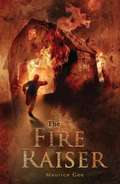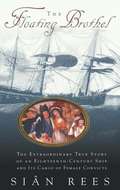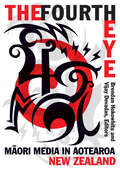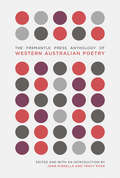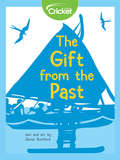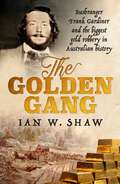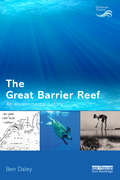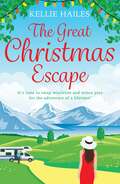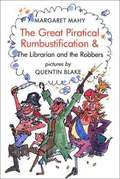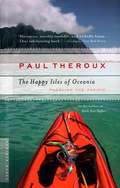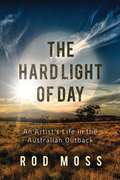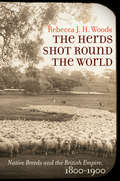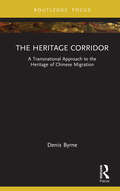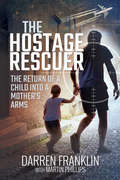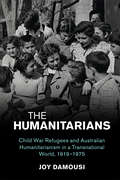- Table View
- List View
The Fire Raiser
by Maurice GeeThe night Dargie's stables burns down, Kitty Wix is knocked tumbling to the ground by strange, loping man fleeing the scene. Who is the fire-raiser who has been terrorizing the small town? Kitty and her friend Irene begin to have their suspicions as to who has been committing the crimes, as do Kitty's brother Noel and his friend Phil. Their curiosity leads them to reluctantly join forces to try and track down the arsonist. The children know they will have to act fast and catch the fire-raiser in the act for anyone to believe them. While Noel and Phil keep watch, the fire-raiser a madman with fires constantly burning in his head, strikes again -- and this time there are lives at stake....
The Floating Brothel: The Extraordinary True Story of an Eighteenth-Century Ship and Its Cargo of Female Convicts
by Sian ReesThis riveting work of rediscovered history tells for the first time the plight of the female convicts aboard the Lady Julian, which set sail from England in 1789 and arrived in Australia's Botany Bay a year later.
The Fourth Eye: Maori Media in Aotearoa New Zealand (Indigenous Americas)
by Brendan Hokowhitu Vijay DevadasFrom the signing of the Treaty of Waitangi between Indigenous and settler cultures to the emergence of the first-ever state-funded Māori television network, New Zealand has been a hotbed of Indigenous concerns. Given its history of colonization, coping with biculturalism is central to New Zealand life. Much of this &“bicultural drama&” plays out in the media and is molded by an anxiety surrounding the ongoing struggle over citizenship rights that is seated within the politics of recognition. The Fourth Eye brings together Indigenous and non-Indigenous scholars to provide a critical and comprehensive account of the intricate and complex relationship between the media and Māori culture. Examining the Indigenous mediascape, The Fourth Eye shows how Māori filmmakers, actors, and media producers have depicted conflicts over citizenship rights and negotiated the representation of Indigenous people. From nineteenth-century Māori-language newspapers to contemporary Māori film and television, the contributors explore a variety of media forms including magazine cover stories, print advertisements, commercial images, and current Māori-language newspapers to illustrate the construction, expression, and production of indigeneity through media.Focusing on New Zealand as a case study, the authors address the broader question: what is Indigenous media? While engaging with distinct themes such as the misrepresentation of Māori people in the media, access of Indigenous communities to media technologies, and the use of media for activism, the essays in this much-needed new collection articulate an Indigenous media landscape that converses with issues that reach far beyond New Zealand. Contributors: Sue Abel, U of Auckland; Joost de Bruin, Victoria U of Wellington; Suzanne Duncan, U of Otago; Kevin Fisher, U of Otago; Allen Meek, Massey U; Lachy Paterson, U of Otago; Chris Prentice, U of Otago; Jay Scherer, U of Alberta; Jo Smith, Victoria U of Wellington; April Strickland; Stephen Turner, U of Auckland.
The Fremantle Press Anthology of Western Australian Poetry
by John Kinsella Tracy RyanThe Fremantle Press Anthology of Western Australian Poetry is a comprehensive survey of the state's poets from the 19th century to today. Featuring work from 134 poets, and including the work of many WA Indigenous poets, this watershed anthology brings together the poems that have contributed to and defined the ways that Western Australians see themselves.
The Future Keepers
by Nandi ChinnaThe poems in The Future Keepers honour ecosystems and thecustodians of future ecologies. They navigate the poet's ownembodied experiences of change and succession – of family,community and place. From the research scientists, gardeners, birdsand plants of Kings Park, to the activism and ecosystems of the BeeliarWetlands, to the poet's own inherited landscapes, these poems evokemutuality and exchange in speaking of the gifts we receive from beingopen to encounters with other species, and the reciprocity that thesegifts imply.
The Future of Australian Federalism
by Gabrielle Appleby Nicholas Aroney Thomas John"At a time when the operation and reform of federal relations within Australia is squarely on the political agenda, this volume brings together eminent lawyers, economists and political scientists who explain, analyse and evaluate the theory and principles underpinning the Australian federal system. Topics covered include the High Court's approach to the interpretation of the Constitution and how this has influenced federal relations in practice; different forms of inter-governmental co-operative arrangements; fiscal relations between the Commonwealth and the States; and emergent ethno-cultural and socioeconomic diversity within the Australian Federation. Comparative perspectives from Germany, America, Canada, Switzerland, India and the European Union provide unique prisms through which to view the operation of the Australian system and to contemplate its reform"--
The Gift from the Past
by James RumfordGenerations of navigators have passed down their knowledge about how to read the sky, waves, land, and sea to find their way. Read about one man whose ancient skills helped solve a mystery.
The Gold Crusades: A Social History of Gold Rushes, 1849-1929
by Douglas FetherlingAmong the hordes of starry-eyed 'argonauts' who flocked to the California gold rush of 1849 was an Australian named Edward Hargraves. He left America empty-handed, only to find gold in his own backyard. The result was the great Australian rush of the 1850s, which also attracted participants from around the world. A South African named P. J. Marais was one of them. Marais too returned home in defeat - only to set in motion the diamond and gold rushes that transformed southern Africa. And so it went. Most previous historians of the gold rushes have tended to view them as acts of spontaneous nationalism. Each country likes to see its own gold rush as the one that either shaped those that followed or epitomized all the rest. InThe Gold Crusades: A Social History of Gold Rushes, 1849-1929, Douglas Fetherling takes a different approach. Fetherling argues that the gold rushes in the United States, Canada, Australia, New Zealand, and South Africa shared the same causes and results, the same characters and characteristics. He posits that they were in fact a single discontinuous event, an expression of the British imperial experience and nineteenth-century liberalism. He does so with dash and style and with a sharp eye for the telling anecdote, the out-of-the-way document, and the bold connection between seemingly unrelated disciplines. Originally published by Macmillan of Canada, 1988.
The Golden Gang: Bushranger Frank Gardiner and the biggest gold robbery in Australian history
by Ian W. ShawThe first comprehensive biography of the godfather of Australian bushranging – Frank Gardiner – leader of the Lachlan gang and mastermind of the largest gold heist in Australian history. Atop the hierarchy of Australian bushrangers sits Ned Kelly – the ultimate outlaw – and just below him, the tragic figure of Ben Hall, who joined a gang led by a man whose name today is less well known, but in his time was much more famous than any other: Frank Gardiner. Mastermind of the largest gold robbery in Australia&’s history, Gardiner led an extraordinary life, the full telling of which is long overdue. In a tough country and among a group of tough men, Gardiner was the toughest of them all. But while he engaged in gunfights with police to evade capture, he was always courteous and could lay claim to never killing anyone, and never stole from those who couldn't afford to be robbed. He went by three different surnames in his lifetime and spent almost half of it behind bars, including at some of the colonies' most notorious penal institutions: the Pentridge Stockade, Cockatoo Island and Darlinghurst Gaol. But if Gardiner was never quite the Robin Hood he sometimes imagined himself to be, he was nevertheless a natural leader, and a man capable of inspiring a motley bunch of stockmen and drifters to become the most effective and successful bushranging gang in the country&’s history. His Lachlan gang operated with a clockwork efficiency that culminated in the robbery of the Gold Escort at Eugowra Rocks, and from 1861 to 1863 it held reign over the roads of the Western Plains of New South Wales.Richly detailed, The Golden Gang shines a new light onto Gardiner's remarkable life – one that ended in shocking tragedy – and reinstates him in the pantheon of Australian outlaw heroes.
The Good International Citizen
by David Horner John ConnorVolume 3 of the official history of Australian peacekeeping, humanitarian and post-cold war operations explores Australia's involvement in six overseas missions following the end of the Gulf War: Cambodia (1991–99); Western Sahara (1991–94); the former Yugoslavia (1992–2004); Iraq (1991); Maritime Interception Force operations (1991–99); and the contribution to the inspection of weapons of mass destruction facilities in Iraq (1991–99). These missions reflected the increasing complexity of peacekeeping, as it overlapped with enforcement of sanctions, weapons inspections, humanitarian aid, election monitoring and peace enforcement. Granted full access to all relevant Australian Government records, David Horner and John Connor provide readers with a comprehensive and authoritative account of Australia's peacekeeping operations in Asia, Africa and Europe.
The Great Barrier Reef: An Environmental History (Earthscan Oceans)
by Ben DaleyThe Great Barrier Reef is located along the coast of Queensland in north-east Australia and is the world's largest coral reef ecosystem. Designated a World Heritage Area, it has been subject to increasing pressures from tourism, fishing, pollution and climate change, and is now protected as a marine park. This book provides an original account of the environmental history of the Great Barrier Reef, based on extensive archival and oral history research. It documents and explains the main human impacts on the Great Barrier Reef since European settlement in the region, focusing particularly on the century from 1860 to 1960 which has not previously been fully documented, yet which was a period of unprecedented exploitation of the ecosystem and its resources. The book describes the main changes in coral reefs, islands and marine wildlife that resulted from those impacts. In more recent decades, human impacts on the Great Barrier Reef have spread, accelerated and intensified, with implications for current management and conservation practices. There is now better scientific understanding of the threats faced by the ecosystem. Yet these modern challenges occur against a background of historical levels of exploitation that is little-known, and that has reduced the ecosystem's resilience. The author provides a compelling narrative of how one of the world's most iconic and vulnerable ecosystems has been exploited and degraded, but also how some early conservation practices emerged.
The Great Christmas Escape
by Kellie HailesIt's time to swap mistletoe and mince pies for the adventure of a lifetime! Sara's life has been in a bit of a rut. Lately, her job as a photographer has just meant taking photos of happy couples and families all day before returning to her empty flat. And while she normally loves Christmas with her family, this year a part of her just wants to run away. So when her ex-husband Fin gets in touch with a wild idea - a joint work trip to New Zealand - she knows it's crazy... but she says yes!A celebrated travel blogger, Fin has made a career out of following his bliss. As much as he loves Sara, the steady family life she's always wanted is not one he can give her. This trip together is his one chance to win her back. But can he convert her to his impulsive lifestyle? There's only one way to find out. As the two explore the stunning sights and thrills of New Zealand, they're about to discover there's so much more to each other than they ever realised...A Christmas romcom like no other, The Great Christmas Escape by Kellie Hailes is the perfect getaway read this year...
The Great Christmas Escape
by Kellie HailesIt's time to swap mistletoe and mince pies for the adventure of a lifetime! Sara's life has been in a bit of a rut. Lately, her job as a photographer has just meant taking photos of happy couples and families all day before returning to her empty flat. And while she normally loves Christmas with her family, this year a part of her just wants to run away. So when her ex-husband Fin gets in touch with a wild idea - a joint work trip to New Zealand - she knows it's crazy... but she says yes!A celebrated travel blogger, Fin has made a career out of following his bliss. As much as he loves Sara, the steady family life she's always wanted is not one he can give her. This trip together is his one chance to win her back. But can he convert her to his impulsive lifestyle? There's only one way to find out. As the two explore the stunning sights and thrills of New Zealand, they're about to discover there's so much more to each other than they ever realised...A Christmas romcom like no other, The Great Christmas Escape by Kellie Hailes is the perfect getaway read this year...
The Great Piratical Rumbustification And The Librarian And The Robbers
by Margaret MahySummary: In these two stories the protagonists have mischievous fun with a former pirate [who uses a wheelchair] and a band of robbers [who might make good children's librarians]. Other books by Margaret Mahy are available in this library.
The Great Race: The Race Between the English and the French to Complete the Map of Australia
by David HillOn the afternoon of 8 April 1802, in the remote southern ocean, two explorers had a remarkable chance encounter. Englishman Matthew Flinders and Frenchman Nicolas Baudin had been sent by their governments on the same quest: to explore the uncharted coast of the great south land and find out whether the west and east coasts, four thousand kilometres apart, were part of the same island. And so began the race to compile the definitive map of Australia. These men's journeys were the culmination of two hundred years of exploration of the region by the Dutch - most famously Abel Tasman - the Portuguese, the Spanish and by Englishmen such as the colourful pirate William Dampier and, of course, James Cook. The three-year voyages of Baudin and Flinders would see them endure terrible hardships in the spirit of discovery. They suffered scurvy and heat exhaustion, and Flinders was shipwrecked and imprisoned - always knowing he was competing with the French to produce the first map of this mysterious continent. Written from diaries and other first-hand accounts, this is the thrilling story of men whose drawings recorded countless previously unknown species and turned mythical creatures into real ones, and whose skill and determination enabled Terra Australis Incognita to become Australia.
The Great Race: The Race Between the English and the French to Complete the Map of Australia
by David HillOn the afternoon of 8 April 1802, in the remote southern ocean, two explorers had a remarkable chance encounter. Englishman Matthew Flinders and Frenchman Nicolas Baudin had been sent by their governments on the same quest: to explore the uncharted coast of the great south land and find out whether the west and east coasts, four thousand kilometres apart, were part of the same island. And so began the race to compile the definitive map of Australia. These men's journeys were the culmination of two hundred years of exploration of the region by the Dutch - most famously Abel Tasman - the Portuguese, the Spanish and by Englishmen such as the colourful pirate William Dampier and, of course, James Cook. The three-year voyages of Baudin and Flinders would see them endure terrible hardships in the spirit of discovery. They suffered scurvy and heat exhaustion, and Flinders was shipwrecked and imprisoned - always knowing he was competing with the French to produce the first map of this mysterious continent. Written from diaries and other first-hand accounts, this is the thrilling story of men whose drawings recorded countless previously unknown species and turned mythical creatures into real ones, and whose skill and determination enabled Terra Australis Incognita to become Australia.
The Happy Isles of Oceania: Paddling the Pacific
by Paul TherouxThe author of The Great Railway Bazaar explores the South Pacific by kayak: &“This exhilarating epic ranks with [his] best travel books&” (Publishers Weekly). In one of his most exotic and adventuresome journeys, travel writer Paul Theroux embarks on an eighteen-month tour of the South Pacific, exploring fifty-one islands by collapsible kayak. Beginning in New Zealand's rain forests and ultimately coming to shore thousands of miles away in Hawaii, Theroux paddles alone over isolated atolls, through dirty harbors and shark-filled waters, and along treacherous coastlines. Along the way, Theroux meets the king of Tonga, encounters street gangs in Auckland, and investigates a cargo cult in Vanuatu. From Australia to Tahiti, Fiji, Easter Island, and beyond, this exhilarating tropical epic is full of disarming observations and high adventure.
The Hard Light of Day: An Artist's Life in the Australian Outback
by Rod MossA rare glimpse into the Australian heartland and the interactions of black and white Australians through the eyes of an artist.Two years after artist Rod Moss arrived in Alice Springs in Australia’s outback to teach painting, he met an indigenous couple who had set up camp in the gully beside his home. Over the next twenty-five years, his friendship with Xavier and Petrina Neil and the friendships that grew from it with the families of Whitegate, an Arrernte aboriginal camp on the outskirts of town, would nourish and challenge Moss beyond his imagining.The Hard Light of Day offers a rare insight into the reality of life in the Outback, from the contours of the MacDonnell Ranges and the textures and sounds of Arrernte culture, to the endemic violence, alcoholism and ill-health that continue to devastate Aboriginal lives. In recalling the relationships and experiences that have shaped his life and work in Alice Springs, Moss reveals the human face behind the statistics and celebrates the enriching, transformative power of friendship. Illustrated with Moss's evocative paintings and photographs, The Hard Light of Day is an incredible journey into a world that is rarely glimpsed, and an artist's chronicle of the moments that have inspired him.
The Hard Slog
by Karl JamesThis edition features the exact same content as the traditional text in a convenient, three-hole-punched, loose-leaf version. Books a la Carte also offer a great value-this format costs significantly less than a new textbook. Bob Blitzer has inspired thousands of students with his engaging approach to mathematics, making this beloved series the #1 in the market. Blitzer draws on his unique background in mathematics and behavioral science to present the full scope of mathematics with vivid applications in real-life situations. Students stay engaged because Blitzer often uses pop-culture and up-to-date references to connect math to students' lives, showing that their world is profoundly mathematical.
The Herds Shot Round the World: Native Breeds and the British Empire, 1800–1900 (Flows, Migrations, and Exchanges)
by Rebecca J. WoodsAs Britain industrialized in the early nineteenth century, animal breeders faced the need to convert livestock into products while maintaining the distinctive character of their breeds. Thus they transformed cattle and sheep adapted to regional environments into bulky, quick-fattening beasts. Exploring the environmental and economic ramifications of imperial expansion on colonial environments and production practices, Rebecca J. H. Woods traces how global physiological and ecological diversity eroded under the technological, economic, and cultural system that grew up around the production of livestock by the British Empire. Attending to the relationship between type and place and what it means to call a particular breed of livestock "native," Woods highlights the inherent tension between consumer expectations in the metropole and the ecological reality at the periphery.Based on extensive archival work in the United Kingdom, New Zealand, and Australia, this study illuminates the connections between the biological consequences and the politics of imperialism. In tracing both the national origins and imperial expansion of British breeds, Woods uncovers the processes that laid the foundation for our livestock industry today.
The Heritage Corridor: A Transnational Approach to the Heritage of Chinese Migration (Routledge Research on Museums and Heritage in Asia)
by Denis ByrneThe Heritage Corridor argues for a transnational approach to investigating and recording heritage places that emerge from histories of migration. Addressing the material legacy of migration, this book also relates it to issues of contemporary importance. Presenting an image of the built environment of migration as one shaped by the ongoing flows of people, ideas, objects and money that circulate through migration corridors, Byrne proposes that houses and other structures built by migrants in their home villages in China over the period 1840–1940 should be seen as crystallisations of the labour, aspirations and longings enacted and experienced by their builders while overseas. Demonstrating that the material world of the migrant is distributed across transnational space, the book calls for an approach to the heritage of migration that is similarly expansive. It proposes and illustrates new methods and strategies for heritage practice. The Heritage Corridor is a book for scholars and students in the fields of critical heritage studies, migration studies and Chinese diasporic mobilities. It is designed to be accessible to heritage practitioners, readers with an interest in the material worlds of migration, past and present, and to all those with an interest in the ‘archaeology’ of transnational migration.
The High Court, the Constitution and Australian Politics
by George Williams Rosalind Dixon George Williams Rosalind DixonThe High Court, the Constitution and Australian Politics is an in-depth exploration of the relationship between decisions of the High Court and broader political currents in Australia. It begins with an investigation of the patterns and effects of constitutional invalidation and dissent on the High Court over time, and their correlation with political trends and attitudes. It also examines the role of constitutional amendment in expressing popular constitutional understandings in the Australian system. Subsequent chapters focus on the eras marked by the tenure of the Court's 12 Chief Justices, examining Court's decisions in the context of the prevailing political conditions and understandings of each. Together, the chapters canvass a rich variety of accounts of the relationship between constitutional law and politics in Australia, and of how this relationship is affected by factors such as the process of appointment for High Court judges and the Court's explicit willingness to consider political and community values.
The Hostage Rescuer: The Return of a Child into a Mother's Arms
by Martin Phillips Darren FranklinThe gripping true crime story of a child abducted by his father from his mother, and the international race to rescue him against dangerous odds.Two close encounters with death convince Darren Franklin that his career in global private security is not the healthiest. Meanwhile Scottish nurse Diane is on a life-changing journey of her own after a Shirley Valentine-style romance on a Greek holiday island. As she moves to Australia to marry her Greek lover and start a family, Darren escapes a contract on his life and teams up with a former British special forces operative to get into the business of rescuing abducted children. Then Darren’s and Diane’s paths cross. After Diane’s marriage breaks down, her ex takes their four-year-old son Theo back to the Greek islands, and, when all attempts to get her son back via the courts have failed, Darren’s company is called in to get him back. As Diane waits anxiously in the wings, Darren and his small team must contend with hostile locals, double-crossing police, and dubious legal contacts to conduct surveillance on their target, formulate a plan, and grab the boy before making their hazardous escape. They can trust no one. A whole island community is against them, they have their suspicions about their own lawyer, and the charity go-between on their team is actively leaking details of their plans, risking their mission, and possibly their lives. Set against an epidemic of parental abductions, and a background of frequent failed recoveries, the action swings from Britain to South America to Australia, to the USA and the Greek Islands on a dramatic, emotional roller coaster from start to finish.
The Hostage Rescuer: The Return of a Child into a Mother's Arms
by Martin Phillips Darren FranklinThe gripping true crime story of a child abducted by his father from his mother, and the international race to rescue him against dangerous odds.Two close encounters with death convince Darren Franklin that his career in global private security is not the healthiest. Meanwhile Scottish nurse Diane is on a life-changing journey of her own after a Shirley Valentine-style romance on a Greek holiday island. As she moves to Australia to marry her Greek lover and start a family, Darren escapes a contract on his life and teams up with a former British special forces operative to get into the business of rescuing abducted children. Then Darren’s and Diane’s paths cross. After Diane’s marriage breaks down, her ex takes their four-year-old son Theo back to the Greek islands, and, when all attempts to get her son back via the courts have failed, Darren’s company is called in to get him back. As Diane waits anxiously in the wings, Darren and his small team must contend with hostile locals, double-crossing police, and dubious legal contacts to conduct surveillance on their target, formulate a plan, and grab the boy before making their hazardous escape. They can trust no one. A whole island community is against them, they have their suspicions about their own lawyer, and the charity go-between on their team is actively leaking details of their plans, risking their mission, and possibly their lives. Set against an epidemic of parental abductions, and a background of frequent failed recoveries, the action swings from Britain to South America to Australia, to the USA and the Greek Islands on a dramatic, emotional roller coaster from start to finish.
The Humanitarians: Child War Refugees and Australian Humanitarianism in a Transnational World, 1919–1975 (Studies in the Social and Cultural History of Modern Warfare)
by Joy DamousiSpanning six decades from the formation of the Save the Children Fund in 1919 to humanitarian interventions during the Vietnam War, The Humanitarians maps the national and international humanitarian efforts undertaken by Australians on behalf of child refugees. In this longitudinal study, Joy Damousi explores the shifting forms of humanitarian activity related to war refugee children over the twentieth century, from child sponsorship, the establishment of orphanages, fundraising, to aid and development schemes and campaigns for inter-country adoption. Framed by conceptualisations of the history of emotions, and the limits and possibilities afforded by empathy and compassion, she considers the vital role of women and includes studies of unknown, but significant, women humanitarian workers and their often-traumatic experience of international humanitarian work. Through an examination of the intersection between racial politics and war refugees, Damousi advances our understanding of humanitarianism over the twentieth century as a deeply racialised and multi-layered practice.
